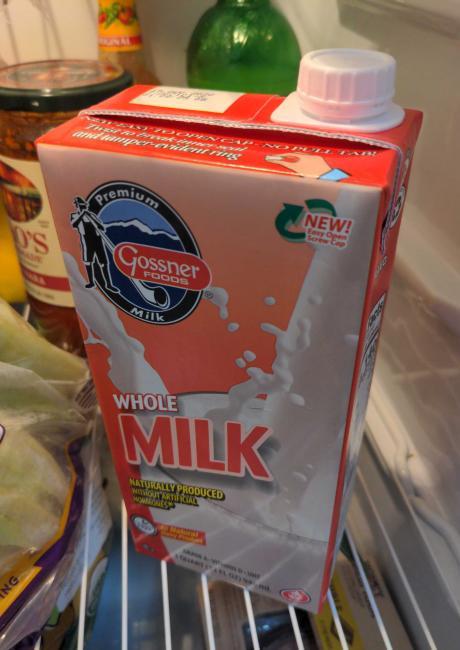Best Survival Foods List for Preppers: Supermarket Prepper Pantry Guide

-
Comments (27)
-
Mr. 357 - September 20, 2020
Ok, we always hear that the fatty layer on Brown rice limits its shelf life to one year. I read this after I had purchased a large amount. But I went ahead with my process: 13 cups in a one gallon bag with oxygen absorber, fold over and seal with flat hair curler, five bags into menards or walmart 5 gallon bucket with lid, store buckets in cool place. I just opened a bag from 2015, and the brown rice is as fresh as the day I bought it 5 years ago, and I’m confident the other 50 bags will last indefinitely, just like white rice. If you are diabetic like me, Brown rice is the right choice.
-
Zabeth - February 10, 2021
Instead of storing brown sugar, store white sugar and jars of molasses. Then you can make your own brown sugar as needed. Instead of storing baking powder, store baking soda and cream of tartar. Then you can make your own baking powder as needed. Consider storing converted rice. It has better nutritional content than white rice, holds up well in casseroles and slow cooked meals, and has a longer shelf-life than brown rice.
-
Sleepwalker - March 19, 2021
It seems like if wheat berries are part of your food storage you shouldn’t count on a electric grinder. My quick google search shows there are hand powered grinders with prices varying from $20 to $500. Do you have suggestions on what to look for in a grinder? Obviously it would need to be of higher quality as it needs to be dependable in an emergency, i just dont have a clue how to tell the good ones from the bad.
-
Zabeth - March 19, 2021
Personally, I like the WonderMill Junior Deluxe for a non-electric grain mill. It comes with both stone and metal burrs so you can grind both dry and oily grains and/or nuts. Also consider getting the flywheel and drill attachments for it, which can give you 2 different ways to motorize the mill if you want to.
-
Sleepwalker - March 19, 2021
Thanks, I’ll look that up.
-
Essie Carroll - March 19, 2021
Years ago I was interested in getting a grain mill and did a bit of research and saw the same thing that you are seeing of so many various prices and features. From what I gathered, many people recommend the Country Living Grain Mill. But with that comes the big price tag.
From my research, I also learned that hand cranking is SLOW! You have to crank for quite a long time to get enough flour to cook with. So what Zabeth said is true, you want to get some way to help you out and motorize that mill. But definitely good to have the basic hand crank as a last case resort like if the power was out.
The WonderMill junior deluxe that she recommends is good as well and comes with various accessories to help speed things up. There’s the drill bit adapter, but I would make sure that you have a decent high torque drill that can withstand the power required. Your cheapo drill probably won’t be able to handle cranking this. Also make sure your drill is variable speed. Some of the older drills that we have are only one speed (high and fast), I think that would put a lot of strain on either the mill or the drill.
If I was to get the WonderMill, I would get the bicycle sprocket converter. It will take a bit of DIYing, but your legs and gear conversions will make it so much more efficient. If you have the room to set up a bike and your mill on a stable surface, this could be a great idea. If you don’t have a bike, or want to keep your bike for bugging out and don’t want to harvest it for this purpose, get a beater bike at the thrift store. It doesn’t have to be pretty or even have all it’s wheels, but make sure it has a comfortable seat and good gearing.
-
July LewisContributor - November 4, 2021
Anyone remember The Long Winter in the Little House on the Prairie series, where they ran out of flour and had to constantly hand-grind wheat in a coffee mill? It was exhausting.
-
Gideon ParkerStaff - November 5, 2021
Little House on the Prairie is such a wholesome and good series isn’t it?
You are right, grinding your own flour does take a long time. Here’s a recent forum thread talking about wheat grinders.
-
-
emcee - August 17, 2021
Anyone have experience with commercial canned/jarred ghee and long term storage? Some sites suggest it can be stored almost indefinitely, but there does not appear to be consensus.
-
Gideon ParkerStaff - October 8, 2021
I’ve made my own ghee before by buying butter from the store, heating it up, and then straining out the milk solids. I had it sitting on my shelf for over a year and it tasted wonderful by the time I got around to eating it.
It wasn’t hard at all, and didn’t require any special equipment that you wouldn’t have in your kitchen except maybe cheese cloth and some mason jars.
-
-
Jeff - October 8, 2021
About the rice: It is my understanding that parboiled (converted rice) stores and cooks like white rice, but has similar flavor and nutrition to brown rice.
-
Gideon ParkerStaff - October 8, 2021
I have not heard of parboiled rice before but just did a search to learn more about it.
To quote Wikipedia: “Parboiled rice is rice that has been partially boiled in the husk. The three basic steps of parboiling are soaking, steaming and drying. These steps make the rice easier to process by hand, while also boosting its nutritional profile, changing its texture, and making it more resistant to weevils.”
Sounds like a superior rice to store if it has boosted nutrition and is more resistant to weevils.
-
Zabeth - October 8, 2021
Parboiled (a/k/a Converted) rice stores longer than brown rice but not as long as white rice. Parboiled rice is more nutritious than white rice (but a bit less nutritious than brown rice) and holds up well in dishes that require a long cooking time, such as casseroles and slow cooker recipes. IMO, it is a good type of rice to store for your mid-range preps (say 5-10 years shelf-life), but you may still want to also store some white rice for your long-term preps.
-
-
Molly N. 😆 - November 18, 2021
I found a box of shelf stable milk 🥛with an expiration date of a year out at the Dollar Tree of all places! It tastes just like any other milk, maybe a bit yummier and creamier actually, and I plan on storing multiple of these in my cupboard.
I’m always running out of milk in the fridge at the worst times like when I need to bake some muffins or have a bowl of cereal at 3am… 😳 But now I can whip this out and be set!
Also comes in 2% and fat free. Go Dollar Tree!
-
brownfox-ffContributor - January 29, 2022
Excellent article.
On the topic of useful cook books:
There is a free PDF cook book named “Good and Cheap”– https://www.leannebrown.com/all-about-good-and-cheap/ (también en español)
The author is from New York and has a Masters in Food Studies. She wrote the book with a specific goal: recipes that let you eat good food on a budget of $4 per day – the budget that was given for the US SNAP / Food Stamps program.
The PDF is completely free to download and use, under a Creative Commons license.
You can also purchase physical copies.The book includes pages on how to shop smartly and how to use a pantry; what staples to stock and how to use them.
I find it quite useful.-
Gideon ParkerStaff - January 29, 2022
Thanks for sharing this cookbook here!
-
-
Vinceb - March 22, 2022
I have MRE style food, can meats, and recently got in to mylar bags and oxygen absorbers. I also put diataneous earth in with he rice and beans. I have a good water plan. Have other thought of a SHTF last min shopping list? idea and number to buy? I have a list of last min food and supplies. Should we see the SHTF, we might have a few hours or days to react to this. If so, I have a list, of thought out supplies to buy. I list created when not under stress. I leave in my cars, just in case, on my way home…
-
M. E.Contributor - March 26, 2022
Sixty-six varieties of canned goods!
After two years of Covid lockdown, I have a pretty good idea of what I will and will not eat in terms of “at home”, shelf-stable food. I had hoped to relax my vigilance a bit but everything going on in Europe has me on edge again. I decided to better organize my canned goods.
So I made a list of all the canned food I have, alphabetized it (to make it easier to organize on my shelves – I’ll just follow the list), and to my complete shock I have sixty-six – 66! – different kinds of just canned food. This does not include my other packaged goods or things in jars; these are actual cans.
This level of variety comes from shopping at three different groceries – all are chains that are commonly found in just about any major metropolitan area in the US (I know many Prepared readers live in other countries or more rural areas with fewer choices). I do all of my shopping online which makes it easy to comparison shop. For example, the butternut squash in one store is a dollar more per can in one store vs. another, but canned soup is cheaper in the other store. Some stores carry canned curry and others don’t; only one store has canned cream. And the availability varies, so I recheck every few months to see what new products are available.
I’m posting a pic of my inventory to help inspire folks who think canned food is boring. There is so much variety here! Many possibilities – like mandarin oranges, spaghetti or ravioli, all kinds of soups, and beans of all kinds – aren’t even on my list because I just don’t eat them. So all the foods on this list are things that either I or my family members like enough to actually eat. My plan is to maintain a list of the nearest expiration date for each thing and as the date approaches, either eat it myself or donate it to a food pantry. I know canned food is usually good past its stamped date, but if it gets to the point of needing to donate to a food pantry (ours won’t take anything past the stamped date), that means it is something I should take out of my inventory since I clearly didn’t eat it enough to keep it in rotation.
-
jaybee - April 16, 2022
You have canned SHRIMP?????
-
M. E.Contributor - April 16, 2022
I do! It is great for seafood soups (I like to mix the shrimp, clams, mussels, and salmon) and for shrimp sandwiches. They are tiny shrimp (it even says “tiny shrimp” on the label, which seems – repetitive?) – not the cocktail kind – but if you want the cocktail kind might I suggest Lehman’s Freeze Dried Shrimp. I have not tried this particular product but their other products are outstanding.
I also just found canned plums so I’m up to 67 varieties! It is really fun to look in the pantry and ask myself, “Well what can I invent today?”
-
Zabeth - April 16, 2022
Great list! Here are a few other unusual commercially canned items I have in my pantry:
Butter (Red Feather)
Cheese (Bega)
Cheese Sauce (Rico’s)
Corn (Whole ears of baby corn)
Escargot (Snails)
Grape Leaves
Herring
Pudding, Chocolate (Large can bought at a restaurant supply store).
Zabeth
-
-
ChargerX - April 11, 2023
Under the canned meats section they should have listed Canned Beef. This is Corned Beef and during WWII it was called “Bully Beef” by the British. It can store 85 years!!!
-
Mark J - April 21, 2023
Storing Shelf Stable Foods verse “Survival Food”. Your article indicates that shelf stable foods are “non perishable” and “Most shelf stable foods are safe indefinitely” per the USDA. Given that, is there any need for the Survival foods? Are the food storage procedures you suggest sufficient for storing the shelf stable foods for 20 to 35 years? Will a can of food sit on a shelf away from heat light, etc. for 20+ years and be edible? Will shelf stable foods in other packaging, e.g.: plastic bags, cardboard boxes, etc. last for 20+ years with proper added packaging?
I understand your caveat about this being an inexact science. I am just looking for some guidance as I get started on having more than a two week supply of food.
-
Zabeth - April 22, 2023
Hi Mark, I do not work for The Prepared but have a very “deep” pantry and am happy to address some of your food storage questions. First, keep in mind that although properly stored food may, after many years in storage, still be “safe” “edible” and “non-perishable,” that does not mean its color, texture, taste, and nutritional value will be anywhere near as good as it was after only a few years in storage. Even when stored in a cool, dark, dry place in a can that has no dents over its seams, no perforations, no leaks, no bulges, and no rust, etc., most canned food will, over time, gradually fade or otherwise change in color, lose some or all of its flavor, lose much of its nutritional value, and may change in texture as well. Personally, I would not plan on storing commercially canned or home canned foods for more than 5 years. Foods that can store well for longer than 5 years include many dehydrated and freeze-dried foods (if properly packaged for long-term storage) and other foods that have less than 10% moisture content (such as un-ground wheat grains/berries, oatmeal, baking soda, non-fat dry milk powder, sugar, etc.). The best method to use to package a food for long-term storage will vary depending on the type of food it is. If you wish, you can tell me the foods you want to store, and I can tell you how I would package and store each one.
-
-
There Are Those Who Call Me... Tim - August 27, 2023
On the brown rice thing…. just before the pandemic (for reasons having nothing to do with prep!) I loaded up on several big bags of brown rice. The bags were sealed plastic. Just over three years later (I’m writing this in June 2023) I’m eating the last of it. It’s still fine.
I’m thinking the kind of bag makes a difference…. a lot of the big bags of rice you get, especially in the little ethnic grocery stores, are kind of meshy or at least porous bags that will probably store less well. I would prefer not to have to repackage anything–aside from being a lot of work, there’s always the question of something getting into it e.g. a bead of sweat dropping off my head if I’m doing it on a hot day, which happened once and ruined one of my bags.
-

